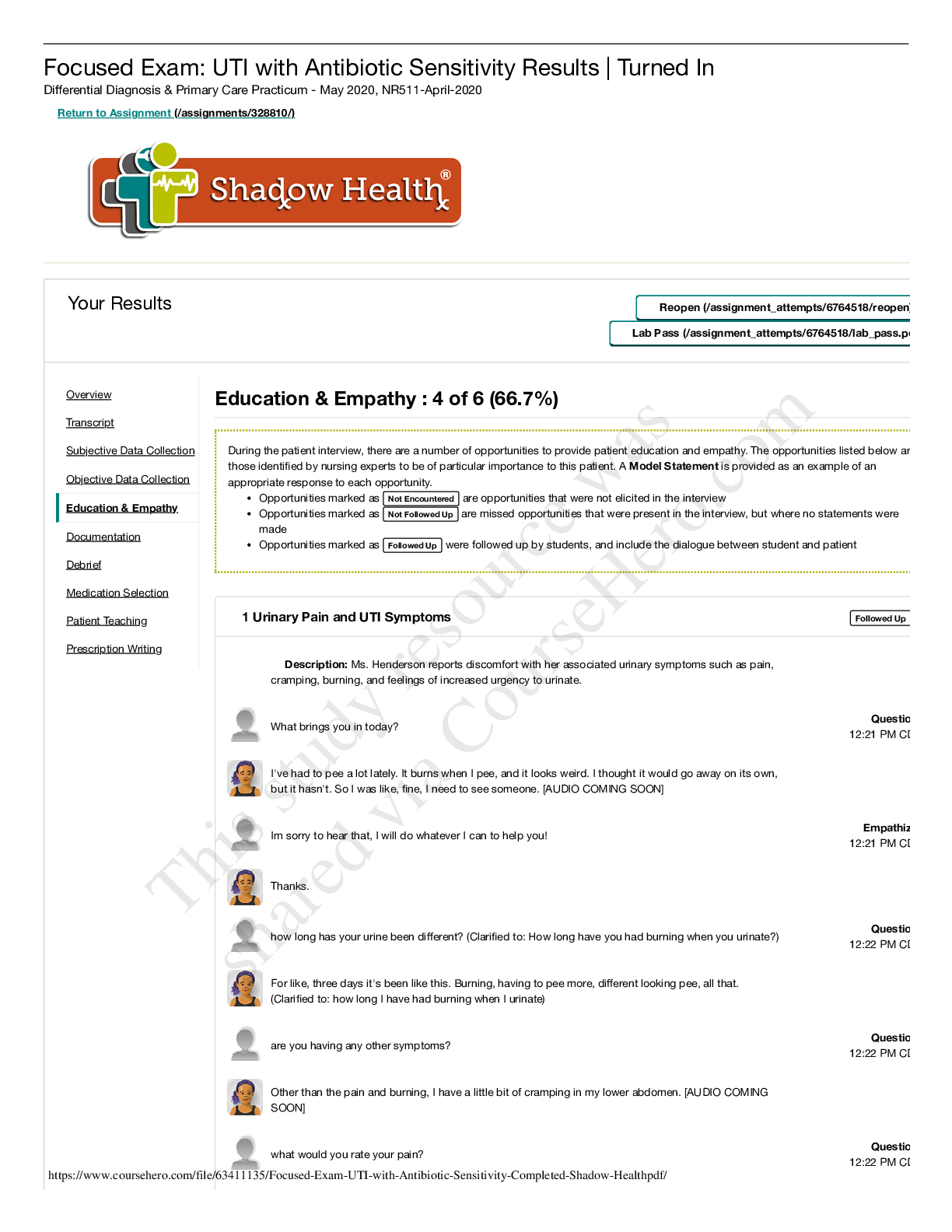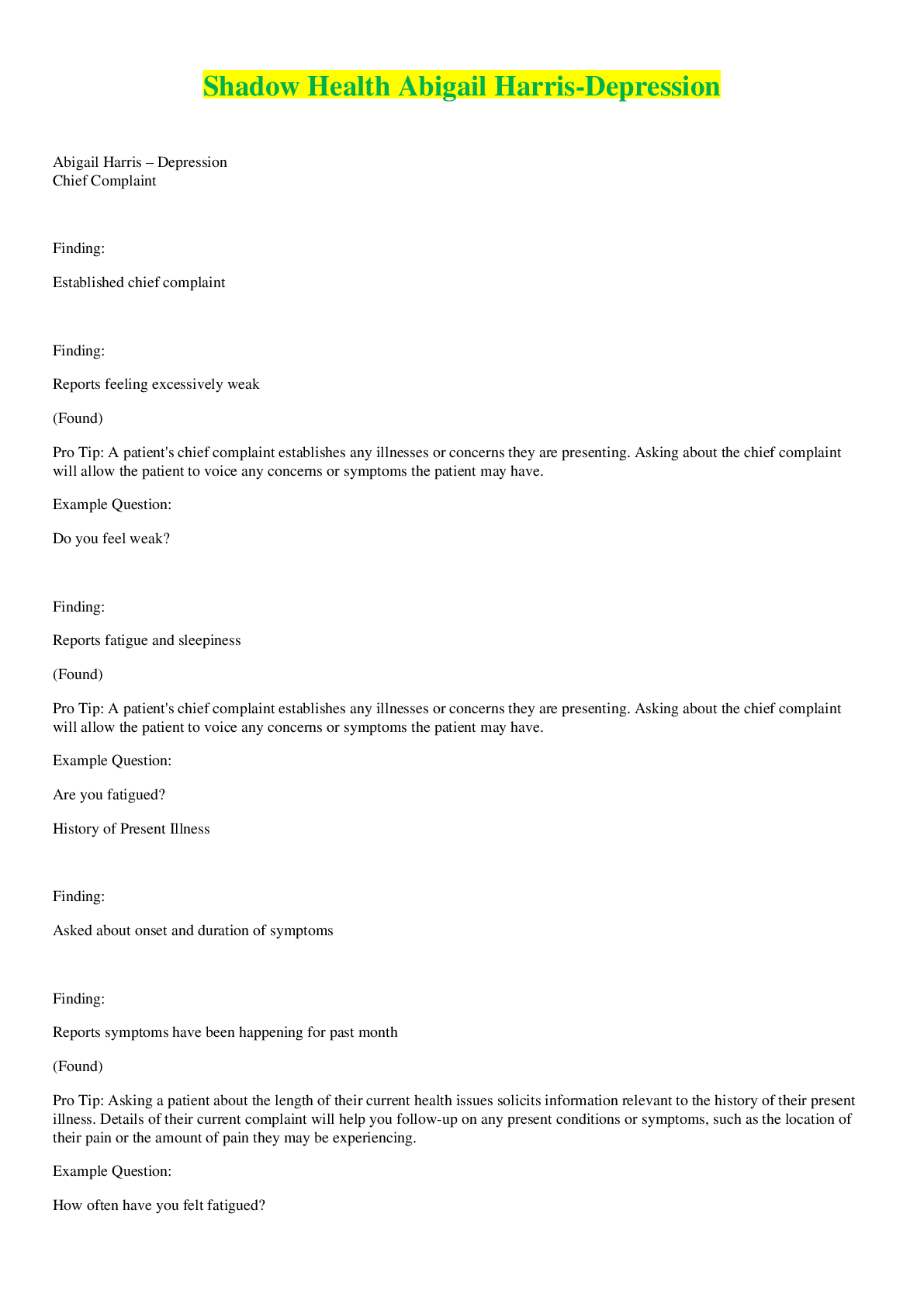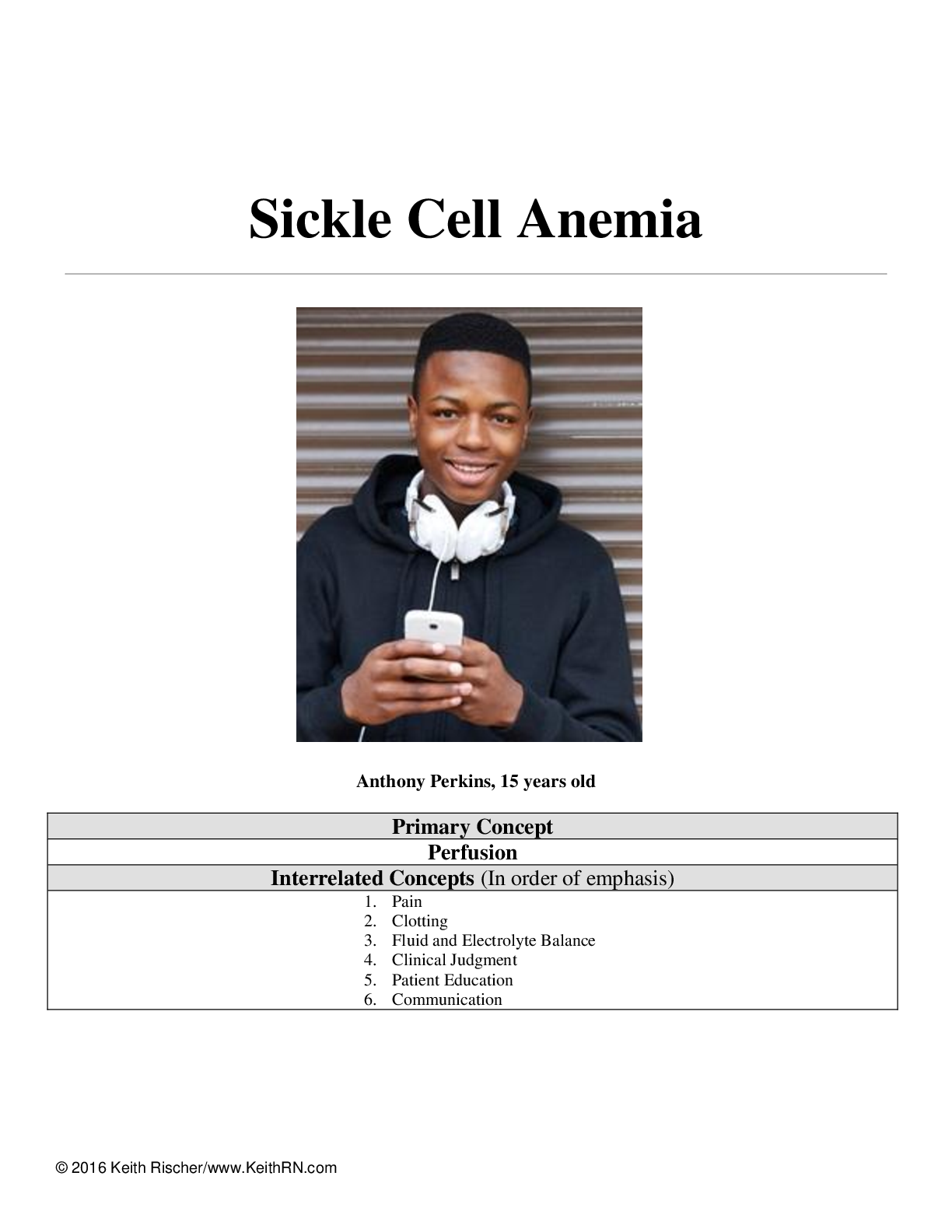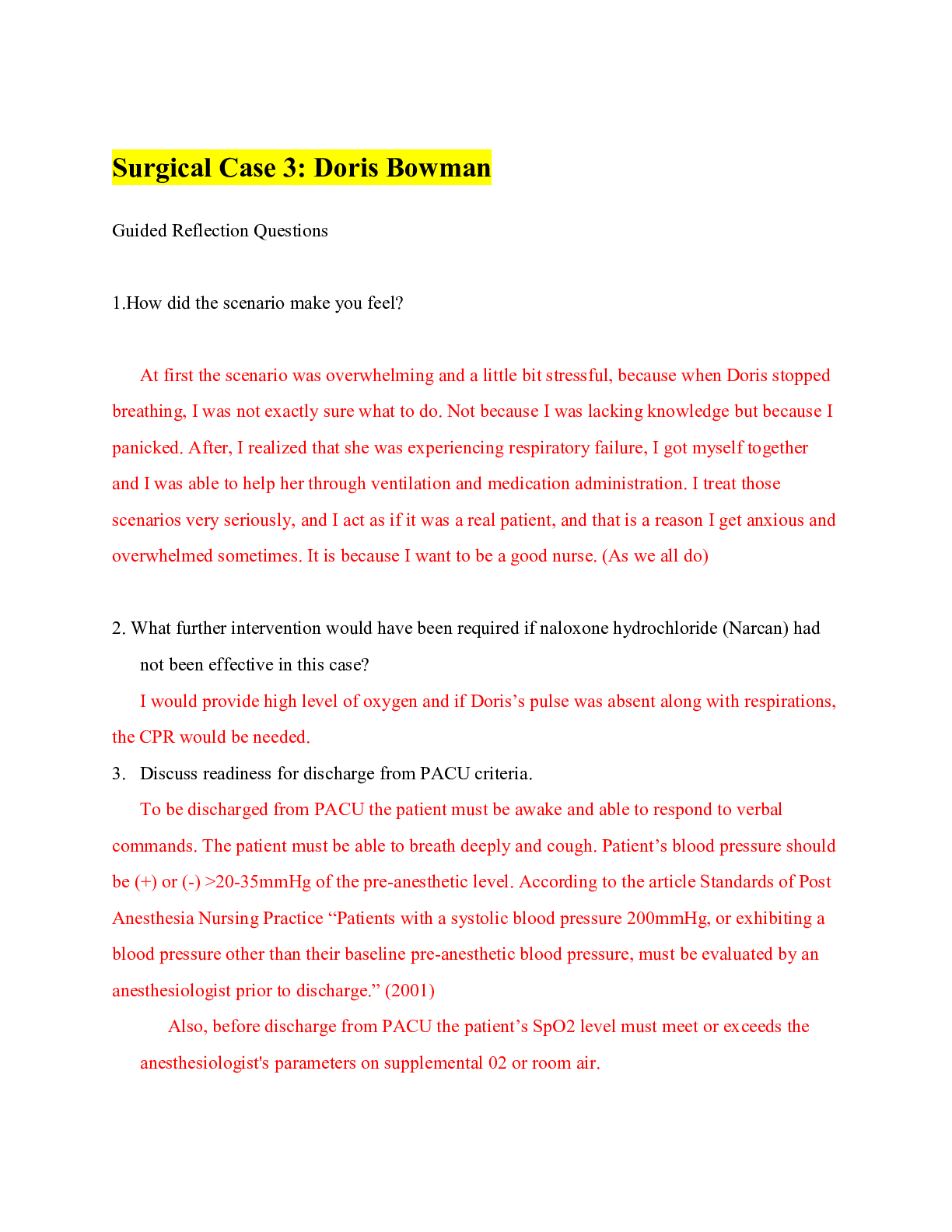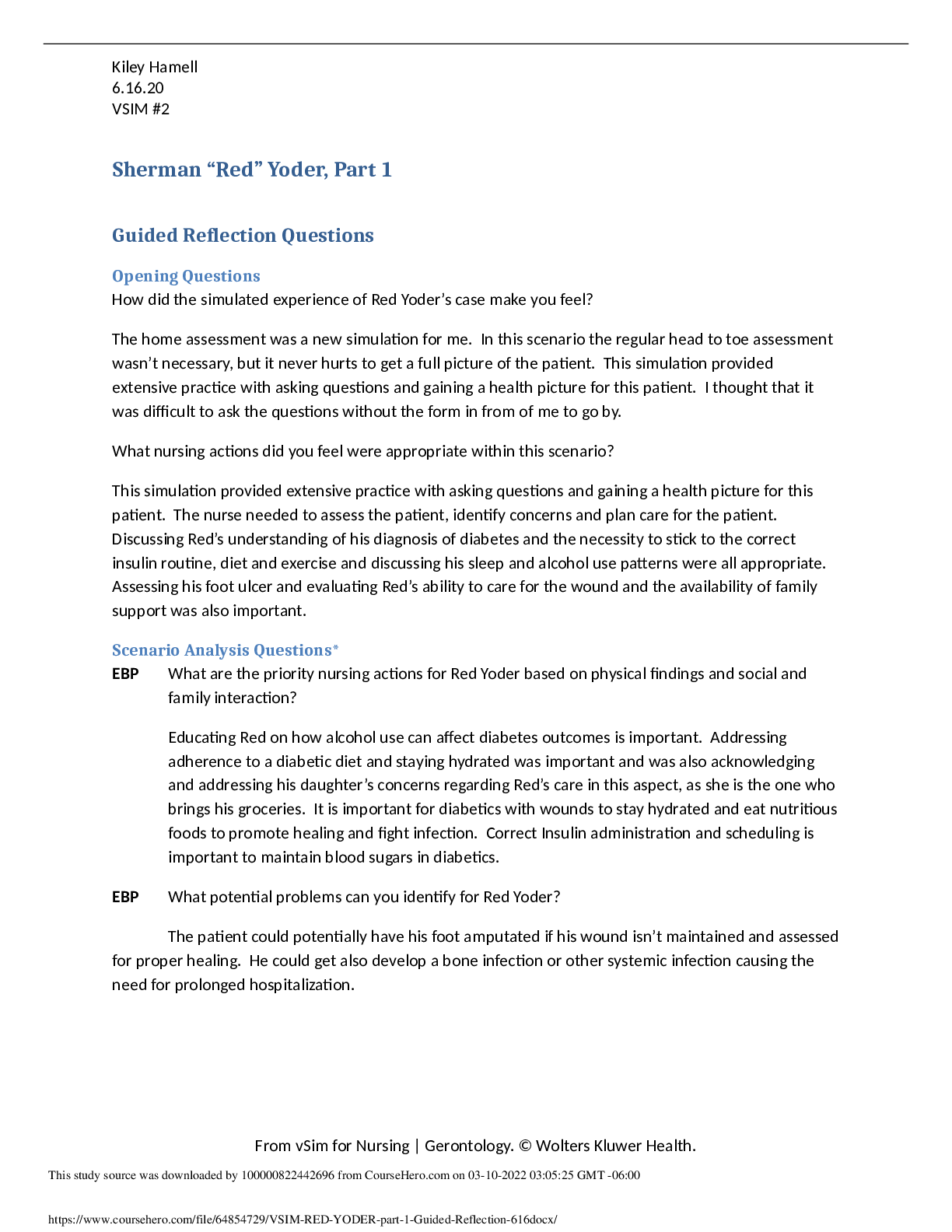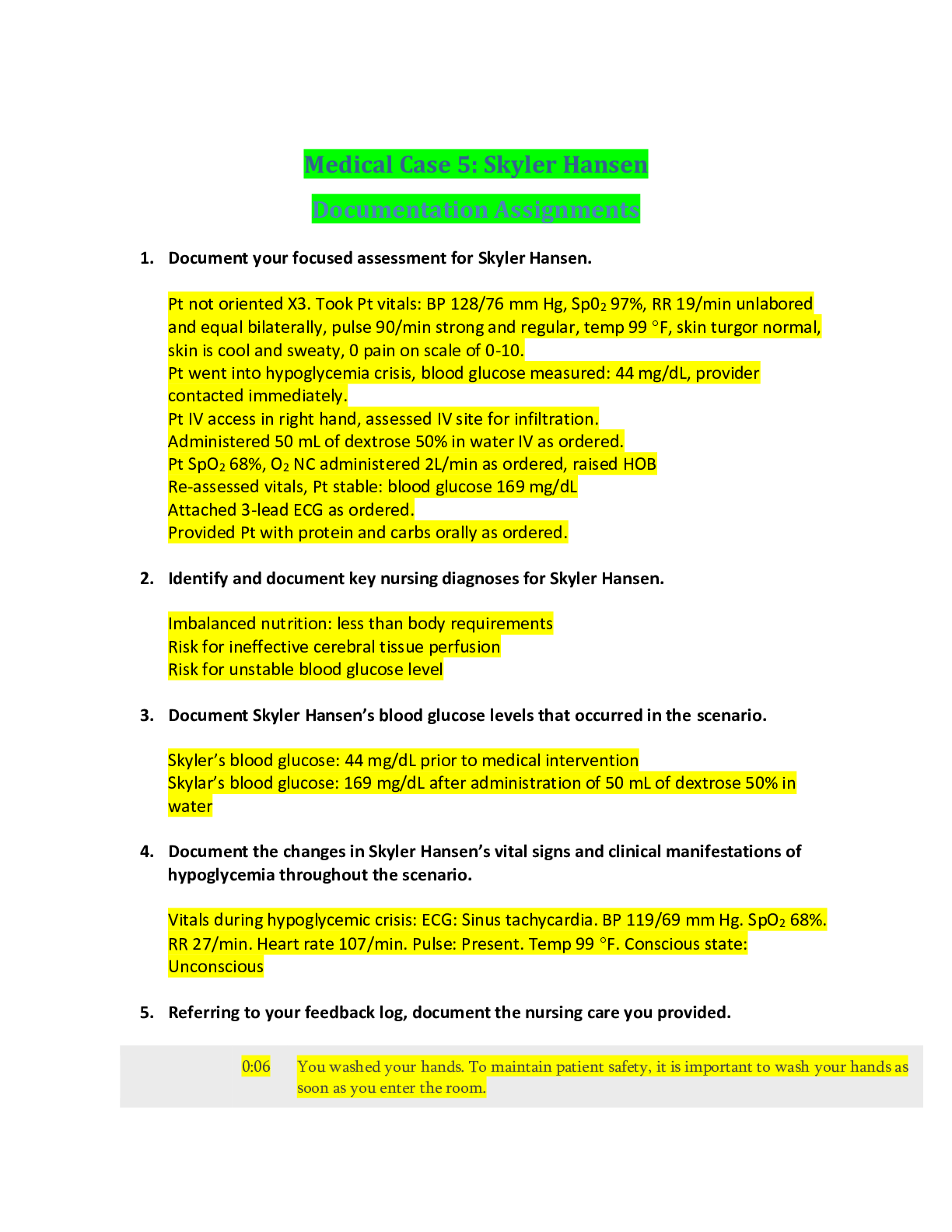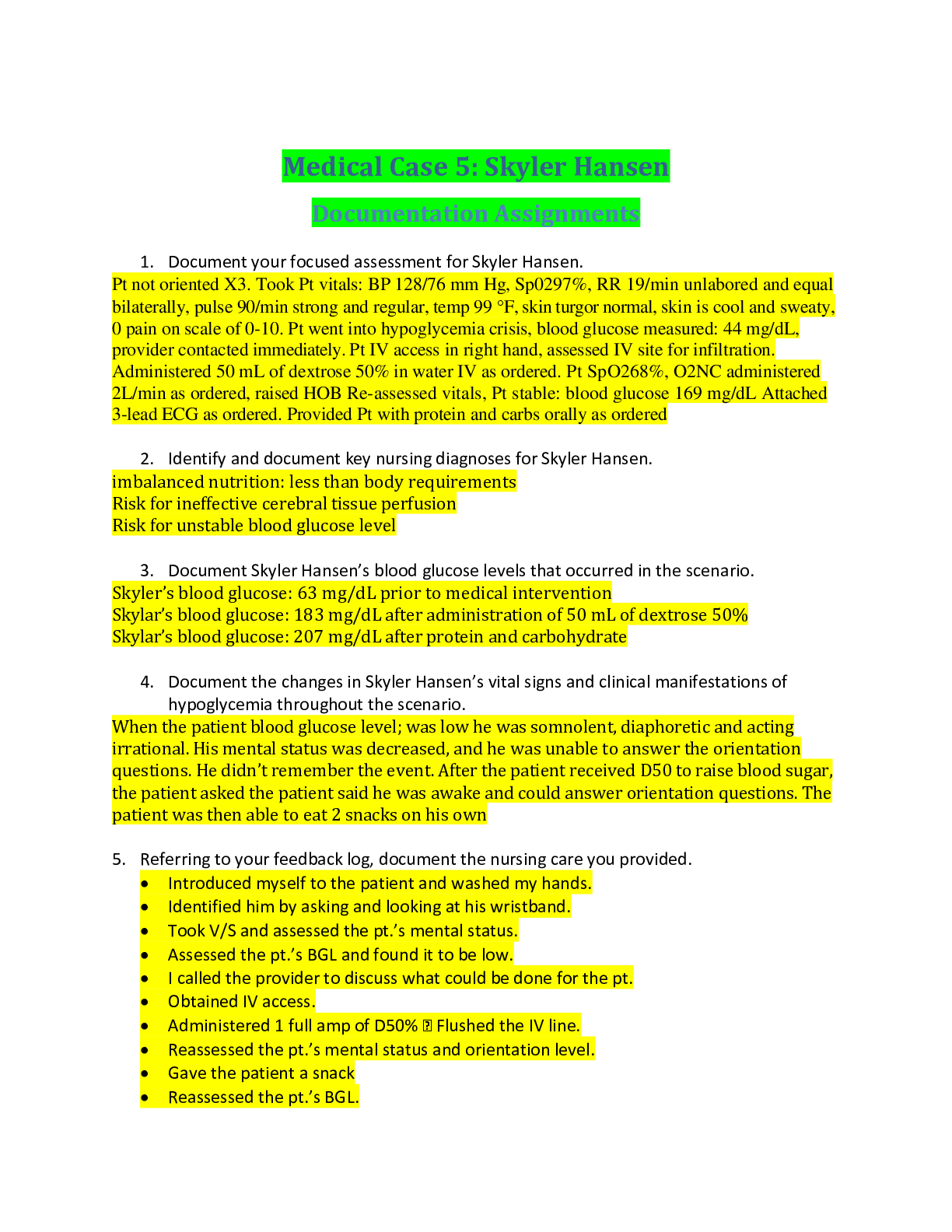*NURSING > CASE STUDY > NRSG 111 Medical Case 5: Skyler Hansen Guided Reflection Questions completed and 100% Aced. (All)
NRSG 111 Medical Case 5: Skyler Hansen Guided Reflection Questions completed and 100% Aced.
Document Content and Description Below
NRSG 111 Medical Case 5: Skyler Hansen Guided Reflection Questions completed and 100% Aced. NRSG 111 Medical Case 5: Skyler Hansen Guided Reflection Questions 1. How did the scenario make you f... eel? I did feel more prepared for this scenario. I felt I knew a lot about diabetes versus other diseases that we have had scenarios over previously. Before the scenario started, I was able to think about what I would need to do. My original thought was I need to assess him then take his glucose level. I decided to asses Skyler then call the doctor and get orders. After I called the doctor, he/she put in the order to take his glucose. I then thought why didn’t I do that before calling? I had the thought but didn’t do it. In real life the doctor would have more than likely asked what his level was. Other than that situation I still felt prepared. I am happy I was able to help Skyler out and know what to do versus the previous scenarios that I had redid multiple times because I didn’t know how to react. 2. What management options would have been appropriate if Skyler Hansen had been alert and could swallow? There are a handful of options that would have been appropriate if Skyler had been alert and swallow such as: fast-acting carbohydrates such as a banana, glucose tablets/gel, fruit juice, regular soda (not diet), and hard candies. Some of the more common juices given are orange juice and grape juice. Common hard candies are life savers (hard ones, not chewy), jelly beans, and licorice. It is important to remember when using one of these options to have a meal to help stabilize the blood sugar. 3. If Skyler Hansen’s acute hypoglycemic episode had not have been treated immediately, what could have happened? If Skyler’s hypoglycemic episode had not been treated immediately many things could have happened to him. To begin with, he could have developed poor coordination and problems with concentration two very important things when you are sick and in need of help. Another issue is seizures. Following seizures there can be periods of confusion, drowsiness, and lethargy. The biggest issue is if Skyler would not have been treated, he could have started passing out that could have led to coma. As with coma, who knows if the patient will wake up or not wake up and if there are complications if the patient wakes up. 4. If too much glucose were administered to Skyler Hansen while the health care team was trying to correct his blood glucose level, what could occur? If Skyler had been given too much glucose while trying to correct his blood glucose levels, there are serious side effects that could happen. Even though some of the side effects could be temporary. Some of the side effects that need to be reported to your physician would be pain, bruising, or swelling at the site of injection, flushing of the skin, confusion, dry mouth/thirst, and passing large amount of urine. As the patient always speak up and ask questions when you feel a little off or when you are unsure what is taking place. 5. Describe age-appropriate patient teaching for Skyler Hansen and resources that may be helpful to him. Due to Skyler’s age as the nurse you need to think how to educate him to where he is going to understand and retain the information. The first education point I would do is bring a glucometer with me into his room and show him how to properly test his glucose levels. Ensuring he is wiping the first bit of blood off then testing his level. I would show him on myself then I would have Skyler show me how to do it. The second thing I would do is print off a list of things he could keep on hand when he travels such as glucose tablets or sugary candy such as licorice. Along with a list of things he should keep on hand for precautions, I would print off a chart of the levels on blood glucose for him to keep just incase he would need to refer to it. 18 is a hard age, you’re between having your parents help you and becoming independent. Possibly a parent was helping Skyler manage his diabetes and he isn’t sure the low/high levels. As well a list of signs/symptoms he should know if his glucose is running low. 6. Discuss confidentiality and legal empowerment of 18-year-old patients such as in Skyler Hansen’s case. Skyler is in the adolescent age (between the ages of 10-19). Many teenagers who turn 18 believe they are an adult and they get to make choices about everything in their life. One of the many issues with adolescents when it comes to healthcare is privacy. Some people will avoid seeking medical care because they “don’t want to tell their parents”. The HIPAA privacy rule helps those adolescent’s health information and records private. Adolescents who are legally adults, such as Skyler, can exercise their rights of this rule. Skyler gets to make his healthcare decisions, if he wants to disclose his health records to his parents/legal guardians then he can make that choice. 7. What would you do differently if you were to repeat this scenario? How would your patient care change? As mentioned in question one, I would have taken Skyler’s glucose level before calling the provider. I felt like that was something that I should have known to do. After doing the scenario, I would have called the provider for the chest tube request then administer the medication order and the other provider orders. I should have known that it would have taken a little bit of time before the provider could put in the chest tube. Maybe in real life I would have been able to leave the room after checking on Skyler while waiting but for the simulation I had to stay on the bedside. If I had the option for vSim to where I can type in questions, I would have asked Skyler more about his diabetes. If he gave himself his insulin, if he draws it up himself, how often he checks his glucose levels, etc. I feel like that would make it more “real life”. Ivy Tech Community College of Indiana Nursing Program – NRSG 111 Student _ ____ Instructor ___________________Date ______________ Virtual Simulation Assignment - Diabetes Virtual simulation day is worth 50 points and 8 clinical hours. Student must complete all criteria to receive full clinical hours. If the assignment is not turned in by established deadline you will receive a zero on the assignment and docked 8 clinical hours. This virtual simulation will help students recognize the signs and symptoms hypoglycemia, evaluate patient assessment data, lab values and implement emergency treatment for hypoglycemia. The student is expected to recognize symptoms of hypoglycemia and treat appropriately. Instructions: Complete the pretest, virtual simulation, post quiz, documentation, and reflection questions. The reflection questions and documentation assignment is located on IvyLearn under assignments. The reflection question need to be posted on IvyLearn. Use the documentation instruction sheet to complete your charting in DocuCare. Submit your completed assignment to proper areas. The assignment must be completed and submitted by the deadline to get full hour and earned points. Students Learning Objectives General: • Selects appropriate patient assessments • Evaluates patient assessment data • Identifies the primary patient care problems/nursing diagnoses • Prioritizes patient care • Implements patient care that meets quality, safety, and evidence-based standards • Utilizes team members as appropriate • Provides patient education Scenario Specific: • Recognizes signs and symptoms of hypoglycemia • Analyzes lab values to identify metabolic imbalance Implements appropriate emergency treatment for hypoglycemia Ivy Tech Community College of Indiana Nursing Program – NRSG 111 Virtual Simulation Assignment - Diabetes Student: Date Assignment Purpose The purpose of this assignment for the student to: 1. Demonstrate responsibility and accountability in the provision of caring, respectful and individualized patient-centered care based on patient values, clinical skills and evidence-based practice. (CLO 1) 2. Demonstrate effective use of technology and standardized, evidence-based practices to support safe and quality patient care. (CLO 2) 3. Function effectively within the scope of practice of a practical nurse or associate degree nurse within the inter/intraprofessional team to achieve quality, individualized patient care. (CLO 3) 4. Apply the principles of individualized teaching-learning to patient care. (CLO 6) Scoring criteria Exemplary: Comprehensively addresses the section criteria completely and accurately, obtaining a 90% mastery level, 100% on post-quiz and evidencing ability to following instruction, apply theory and provide evidenced based practice. In addition, no errors in spelling or grammar on reflection questions and documentation. Satisfactory: Addresses the selected criteria completely obtaining an 80% mastery level, 90% on post-quiz, with 1-2 inaccuracies, evidencing some ability to following instruction, apply theory and provide evidenced based practice. In addition, 1-2 errors in spelling or grammar on reflection questions and documentation. Fair: Limited or incomplete evidence of addressing the selected criteria obtaining an 75% mastery level, 70-80% on post-quiz, with had 2-4 inaccuracies evidencing minimal ability to following instruction, apply theory and provide evidenced based practice. In addition, 3-4 errors in spelling or grammar on reflection questions and documentation. Unsatisfactory: Addressing of the selected criteria is completely inaccurate and incomplete. Obtains <75% mastery level and 70-80% on post-quiz. Shows no evidence of the ability to following instruction, apply theory and provide evidenced based practice. In addition, greater than 5 errors in spelling or grammar on reflection questions and documentation. [Show More]
Last updated: 1 year ago
Preview 1 out of 4 pages
Instant download
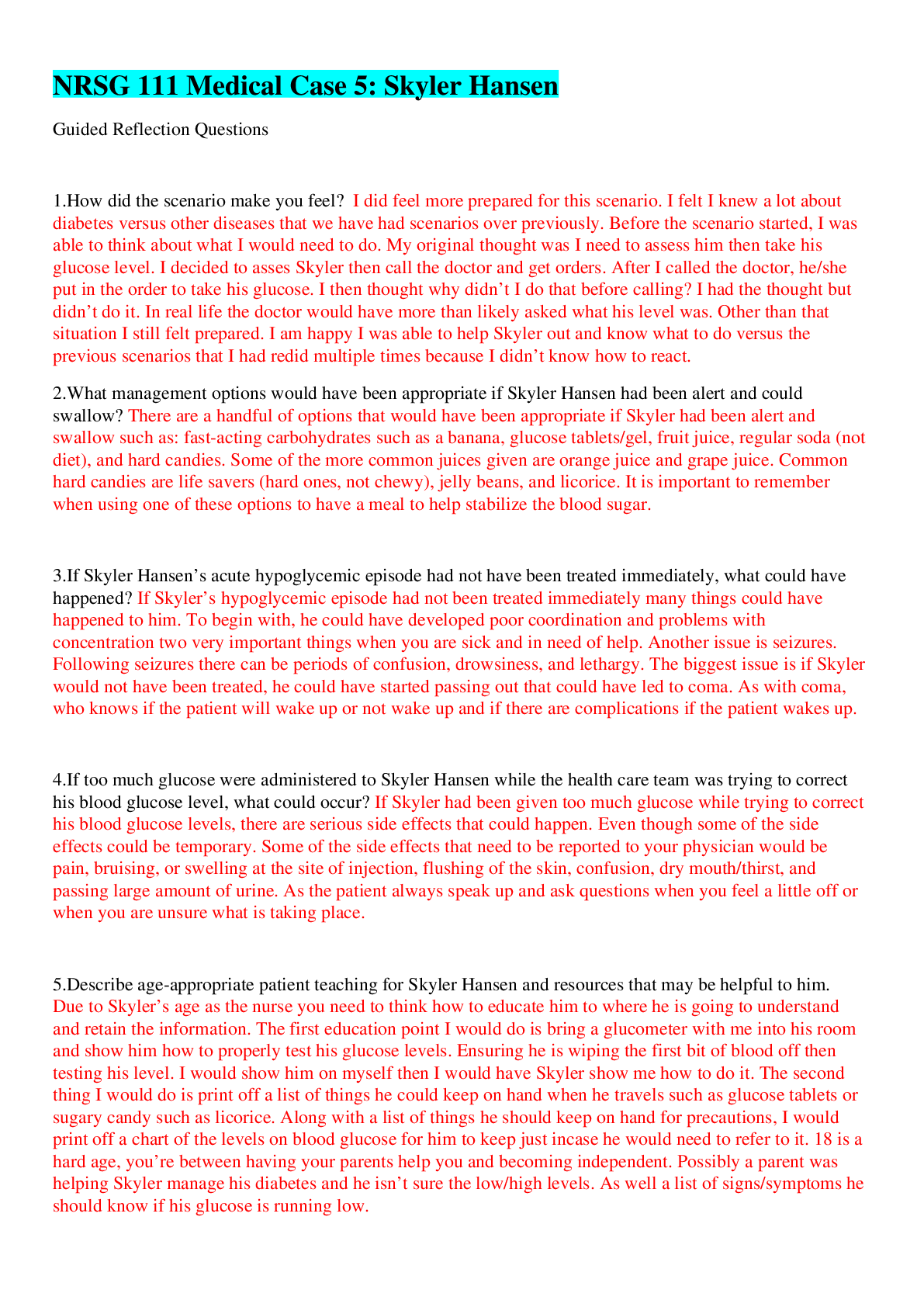
Buy this document to get the full access instantly
Instant Download Access after purchase
Add to cartInstant download
Reviews( 0 )
Document information
Connected school, study & course
About the document
Uploaded On
Nov 22, 2022
Number of pages
4
Written in
Additional information
This document has been written for:
Uploaded
Nov 22, 2022
Downloads
0
Views
46

.png)
